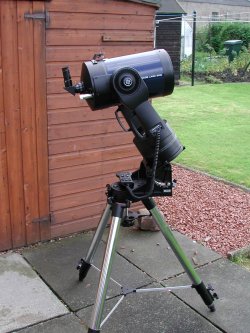Meade LX-90 Telescope Review
I have now owned my Meade 8" LX90 Schmidt-Cassegrain Telescope for a year and my first impression upon receipt of the scope was that it looked very impressive. The scope arrived in 3 boxes; first the Optical Tube Assembly (OTA) comes in a foam-lined box, which keeps it very well protected. Next the tripod comes well wrapped in its box protecting the chromed steel legs, while the third box contains the 8x50 finderscope, autostar controller, 1.25' diagonal prism and the 26mm eyepiece, all well boxed and protected.
The telescope manual is very well written and easy to understand. Assembling the telescope is easy and takes five to ten minutes, just level the tripod sit the telescope on top, tighten and you're ready to go. To get started you set the telescope in the home position, pointing north with the OTA level. When you switch on the telescope the autostar controller lights up and you are given a warning about pointing your telescope at the sun, which you can disable if you wish. Once you have entered the date, time and location the telescope begins aligning; you are presented with one hundred of the brightest stars in the sky to pick from. I prefer the two star alignment method, where I try to pick two stars about one hundred and eighty degrees apart in the sky. The telescope will slew to both stars, centre them in your eyepiece, which you can do manually if you have to and that's it done. It sounds a long progress, but from start to finish it only takes fifteen minutes.
The autostar controller is very easy to use, the GOTO function is great and at last count had 30,223 objects in its database. You just scroll through the database, pick an object and hit the GOTO button. The telescope kicks into life; slews round to the object and beeps, the object should now be in the centre of the eyepiece; if not just hit GOTO again and the telescope will start a slow spiral pattern outwards to find it. Hit GOTO to stop when you find the object, and if you like, hit the question button on the controller and you will be given lots of information about the object you are looking at. One great feature is the guided tour function- just select and the telescope will show you the night's best objects. You can also write your own tours or download new tours from the Internet. The autostar can also be updated from the Internet and you can also clone your autostar controller on to another controller to help update it.
Visually I am more than happy with the views I have seen during the year. It was a good year to see the planets, with lovely views, especially Jupiter with it's belts and moons and Saturn and its rings were amazing, my most viewed object of the year. The LX90 provides great views of deep sky objects and I was very impressed with views of the Globular cluster M13, the Dumbbell Nebula M27 and the Ring Nebula M57. The Whirlpool Galaxy M51 was good, but adding a broadband filter really brought out the structure of the galaxy. The view of the Leo Triplet M65, M66 and NGC 3628 was great, with all three galaxies in the same field of view.
The ability for the telescope to track objects is invaluable, to be able to look at an object then walk away and come back later on and it is still in the centre of the eyepiece is great. Once you have bought the optional add-on, you can fix a camera on top, let the telescope track and take great wide field shots of the sky.
Overall there are some good points and also some bad points. The good points are, the ease of use of the autostar, the software has never locked up after hours of use, the tracking ability and the facility of the telescope to accept input from an autoguider to help with long exposure astrophotography. The bad point's are, the telescope dews up too easy while the height from the base plate to the fork arms is too short (you only notice this if you are looking straight up); buying a dew removal system and a wedge for the tripod minimises these problems without solving them. However, my major criticism is the lack of the slow motion controls, which make the scope hard to work in manual mode'. And would it be too hard to install a bracket to hold the keyboard rather than have it lying about?
Would I recommend this telescope? Yes I would. In the year I have had it I have a great time with it and hope to have some more fun with it this winter.
